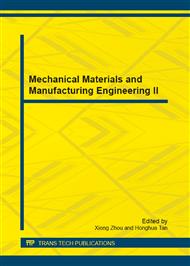[1]
Kusák, I.; Luňák, M., Tracking of concrete by means of impedance spectroscopy - electrical properties and porosity, contribution at Proceedings of the 5th International Conference on dynamics of Civil Engineering and Transport Structures and Wind Engineering, ISBN 978-80-554-0354-0, University of Žilina, (2011).
Google Scholar
[2]
Plšková, I.; Chobola, Z.; Matysík, M., Assessment of ceramic tile frost resistance by means of the frequency inspection method, Ceramics-Silikáty 55.
Google Scholar
[2]
2011, 176-182, ISSN 0862-5468, (2011).
Google Scholar
[3]
Luňák, M.; Kusák, I., An application for the impedance spectroscopy method and building material testing, Ministry of transport, ISSN 1802-971X, Brno, (2010).
DOI: 10.2478/v10158-010-0009-x
Google Scholar
[4]
Kusák, I., Luňák, M., Matysík, M.; Topolář, L., Determination of the performance factor of a heat pump (in Czech), paper in Media4u Magazine, ISSN 1214-9187, http: /www. media4u. cz/, (2010).
Google Scholar
[5]
Pazdera, L.; Topolář, L.; Bílek, V.; Smutný, J.; Kusák, I.; Luňák, M., Measuring of Concrete Properties during Hardening, In ESA 2010. 1. CZ, Palacky University. Pages 311 - 318. ISBN 978-80-244-2533-7, (2010).
Google Scholar
[6]
Luňák, M; Kusák, I; Pazdera L; Topolář, L., Bilek V., Monitoring of cement-based material solidification, focusing on electrical properties, In ESA 2010. 1. CZ, Palacky University. Pages 233-240. ISBN: 978-80-244-2533-7, (2010).
Google Scholar
[7]
Kusák, I.; Luňák, M., Impedance Spectroscopy of Ceramic (Plain) Roofing Tiles, paper in I. International Interdisciplinary Technical Conference of Young Scientist Intertech 2009, ISBN 978-83-926896-0-7, Politechnika Poznan, Poznan, Polsko, (2009).
Google Scholar
[8]
Luňák, M.; Kusák, I., Debye's model of impedance spectroscopy, presented in the 2nd International Interdisciplinary Technical Conference of young scientist Proceedings, ISBN 978-83-926896-1-4, Uczelniany Samorzad Doktorantow Politechniki Poznanskiej, Poznan, (2009).
Google Scholar
[9]
Luňák, M.; Kusák, I.; Pazdera, L., Non Destructive Testing of Cetris-Basic Wood-Cement Chipboards by Using Impedance Spectroscopy, presented at the 10th International Conference of The Slovenian Society for Non-Destructive Testing Application of Contemporary Non-Desructive Testing in Engineering, ISBN 978-961-90610-7-7, Slovensko drustvo, Slovinsko Ljubljana, (2009).
DOI: 10.4028/www.scientific.net/amr.1124.203
Google Scholar
[10]
Kusák, I.; Luňák, M.; Pazdera, L., Impedance spectroscopy of self-compactible concrete during the setting process in: NDT Welding Bulletin 2/2008, Volume 18, 22-25, issued in 10/2008, ISSN 1213-3825, (2008).
Google Scholar
[11]
Luňák, M.; Kusák, I.: Impedance Spectroscopy Measurement Of Concrete Hydration By Miscellaneous Medium, in: InterTech 2008 - International Interdisciplinary Technical Conference of Young Scientist, 122-124, Politechnika Poznan, Polsko, ISBN 978-83-926896-0-7, (2008).
Google Scholar
[12]
Kusák, I.; Luňák, M.; Matysík, M.; Topolář, L., Stanovení topného faktoru tepelného čerpadla, paper in Media4u Magazine, ISSN 1214-9187, http: /www. media4u. cz/, http: /www. media4u. cz/, (2010).
Google Scholar
[13]
Andrade, C.; Blanco, V.M.; Collazo, A; Keddam M.; Novoa, X.R. and Takenouti, H., 1999. Cement paste hardening process studied by impedance spectroscopy, Electrochimie Acta, 44 4313-8.
DOI: 10.1016/s0013-4686(99)00147-4
Google Scholar
[14]
Cabeza, M.; Merino, P.; Miranda, A.; Novoa, X.R. and Sanchez, I., 2002. Impedance spectroscopy study of hardened Portland cement paste, Cement and Concrete Research, 32 881-91.
DOI: 10.1016/s0008-8846(02)00720-2
Google Scholar
[15]
Christensen, B.J.; Coverdale, R.T.; Olson, R.A.; Ford, S.J.; Garboczim, E.J.; Jennings, H.M. and Mason, T.O., 1994. Impedance spectroscopy of hydrating cement based materials: measurement, interpretation, and application, Journal of the American Ceramic Society, 77 2789-804.
DOI: 10.1111/j.1151-2916.1994.tb04507.x
Google Scholar
[16]
Torrents, J.M.; Roncero, J. and Gettu, R., 1998. Utilization of impedance spectroscopy for studying the retarding effect of a superplasticizer on the setting of cement, Cement and Concrete Research, 28 9 1325-1333.
DOI: 10.1016/s0008-8846(98)00110-0
Google Scholar
[17]
Xie, P.; Gu, P.; Fu, Y. and Beaudoin, J.J., 1994. A.C. Impedance phenomena in hydrating cement systems: origin of the high frequency ARC, Cement and Concrete Research, 24 4 704-706.
DOI: 10.1016/0008-8846(94)90194-5
Google Scholar


